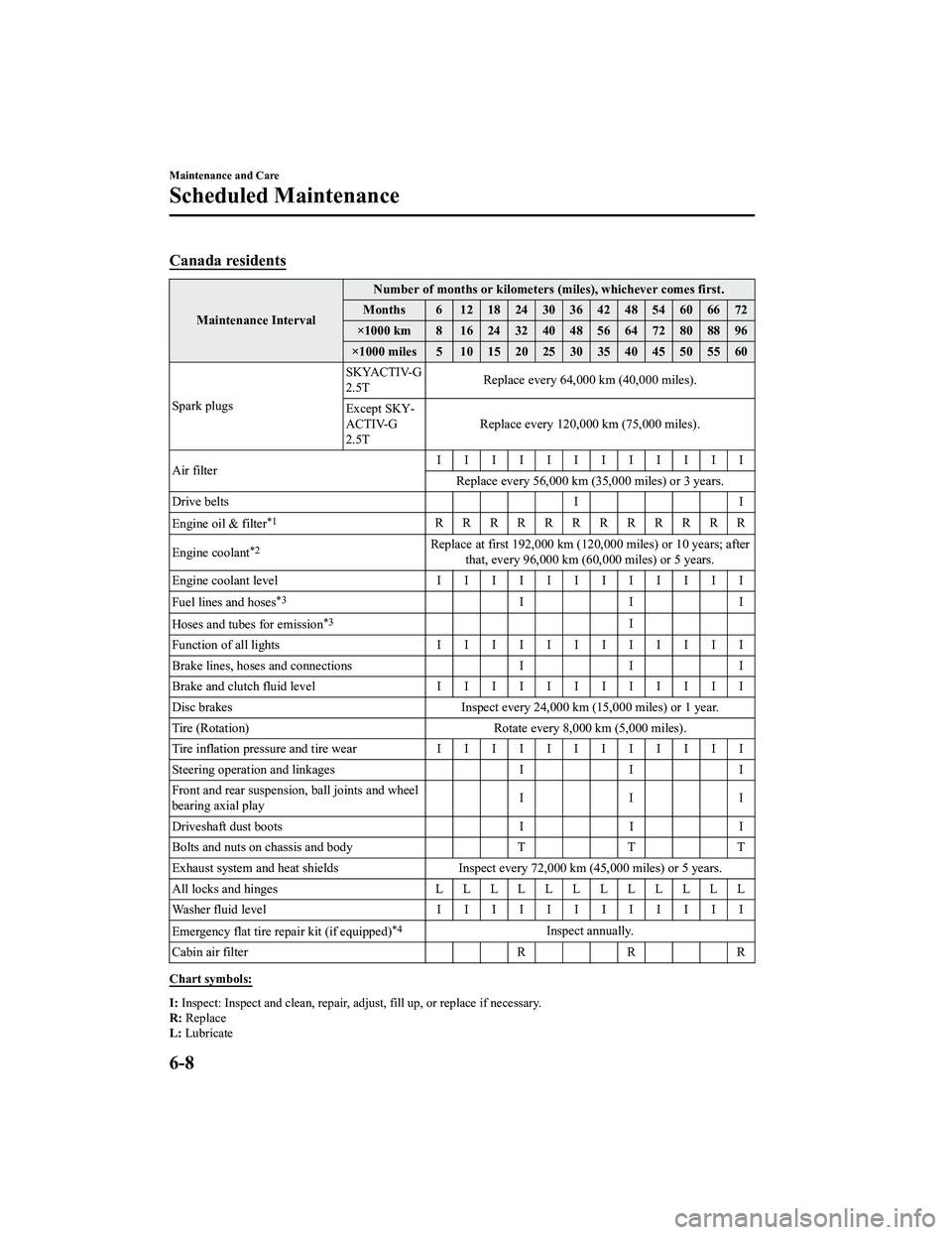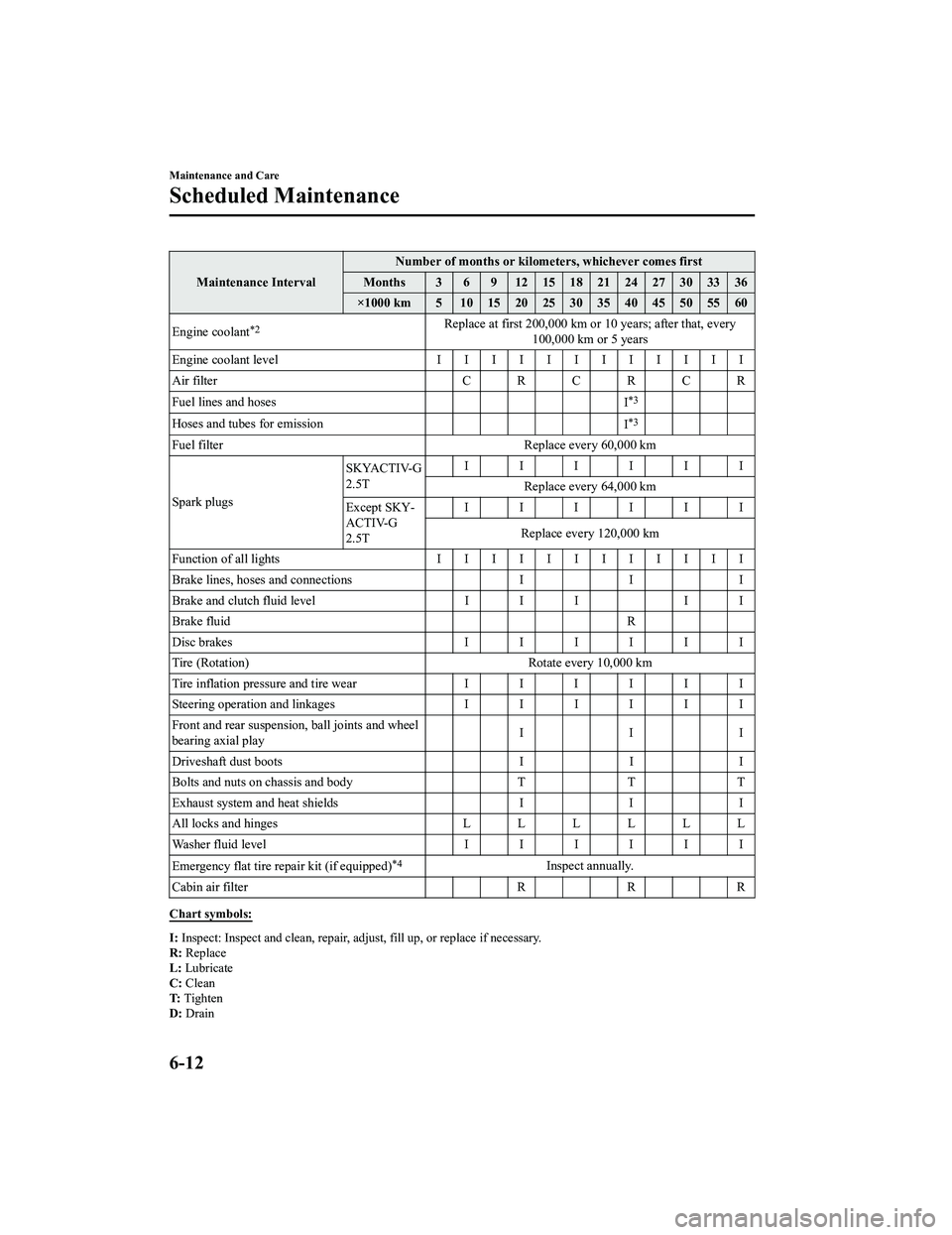suspension MAZDA MODEL CX-5 2022 User Guide
[x] Cancel search | Manufacturer: MAZDA, Model Year: 2022, Model line: MODEL CX-5, Model: MAZDA MODEL CX-5 2022Pages: 723, PDF Size: 89.79 MB
Page 545 of 723

Canada residents
Maintenance IntervalNumber of months or kilometers (miles), whichever comes first.
Months 6 1218243036424854606672
×1000 km 8 1624324048566472808896
×1000 miles 5 10 15 20 25 30 35 40 45 50 55 60
Spark plugs SKYACTIV-G
2.5T
Replace every 64,000 km
(40,000 miles).
Except SKY ‐
ACTIV-G
2.5T Replace every 120,000
km (75,000 miles).
Air filter IIIIIIIIIIII
Replace every 56,000 km (35, 000 miles) or 3 years.
Drive belts II
Engine oil & filter
*1RRRRRRRRRRRR
Engine coolant
*2Replace at first 192,000 km (120,000 miles) or 10 years; after
that, every 96,000 km (60,000 miles) or 5 years.
Engine coolant level IIIIIIIIIIII
Fuel lines and hoses
*3III
Hoses and tubes for emission
*3I
Function of all lights IIIIIIIIIIII
Brake lines, hoses and connections II I
Brake and clutch fluid level IIIIIIIIIIII
Disc brakes Inspect every 24,000 km (15,000 miles) or 1 year.
Tire (Rotation) Rotate every 8,000 km (5,000 miles).
Tire inflation pressure and tire wear IIIIIIIIIIII
Steering operation and linkages II I
Front and rear suspension, ball joints and wheel
bearing axial play III
Driveshaft dust boots II I
Bolts and nuts on chassis and body TTT
Exhaust system and heat shields Inspect every 72,000 km (45,000 miles) or 5 years.
All locks and hinges LLLLLLLLLLLL
Washer fluid level IIIIIIIIIIII
Emergency flat tire repair kit (if equipped)
*4Inspect annually.
Cabin air filter RRR
Chart symbols:
I: Inspect: Inspect and clean, repair, ad just, fill up, or replace if necessary.
R: Replace
L: Lubricate
Maintenance and Care
Scheduled Maintenance
6-8
CX-5_8KN5-EA-21K_Edition1_old 2021-9-9 8:35:12
Page 549 of 723

Maintenance IntervalNumber of months or kilometers, whichever comes first
Months 3 6 9 121518212427303336
×1000 km 5 1015202530354045505560
Engine coolant
*2Replace at first 200,000 km or 10 years; after that, every 100,000 km or 5 years
Engine coolant level IIIIIIIIIIII
Air filter CRCRCR
Fuel lines and hoses I
*3
Hoses and tubes for emission
I*3
Fuel filterReplace every 60,000 km
Spark plugs SKYACTIV-G
2.5T
IIIIII
Replace every 64,000 km
Except SKY ‐
ACTIV-G
2.5T IIIIII
Replace every 120,000 km
Function of all lights IIIIIIIIIIII
Brake lines, hoses and connections II I
Brake and clutch fluid level I I II I
Brake fluid R
Disc brakes IIIIII
Tire (Rotation) Rotate every 10,000 km
Tire inflation pressure and tire wear IIIIII
Steering operation and linkages IIIIII
Front and rear suspension, ball joints and wheel
bearing axial play III
Driveshaft dust boots II I
Bolts and nuts on chassis and body TTT
Exhaust system and heat shields II I
All locks and hinges LLLLLL
Washer fluid level IIIIII
Emergency flat tire repair kit (if equipped)
*4Inspect annually.
Cabin air filter R R R
Chart symbols:
I: Inspect: Inspect and clean, repair, ad just, fill up, or replace if necessary.
R: Replace
L: Lubricate
C: Clean
T: Tighten
D: Drain
Maintenance and Care
Scheduled Maintenance
6-12
CX-5_8KN5-EA-21K_Edition1_old 2021-9-9 8:35:12
Page 679 of 723

Ve h i c l e L o a d i n g
This section will guide you in the proper loading of your vehicle and/or trailer, to keep your
loaded vehicle weight within it s design rating capability, with or without a trailer. Properly
loading your vehicle will provide maximum retu rn of vehicle design performance. Before
loading your vehicle, familiarize yourself with the following terms for determining your
vehicle's weight ratings, with or without a trailer, from the vehicle's Safety Certification
Label and Tire and Load Information Label:
WA R N I N G
Overloaded Vehicle:
Overloading a vehicle is dangerous. The results of overloading can have serious consequences
in terms of passenger safety. Too much weight on a vehicle's suspension system can cause
spring or shock absorber failure, brake failu re, handling or steering problems, irregular tire
wear, tire failure or other damage.
Overloading makes a vehicle harder to drive an d control. It also increases the distance
required for stopping. In cases of serious overloading, brakes can fail completely, particularly
on steep grades. The load a tire will carry safely is a combination of the size of the tire, its load
range, and corresponding inflation pressure.
Never overload the vehicle and always observe th e vehicle's weight ratings from the vehicle's
Safety Certification and Tire and Load Information labels.
Base Curb Weight is the weight of the ve hicle including a full tank of fuel and all
standard equipment. It does not include passengers, carg o, or optional equipment.
Vehicle Curb Weight is the weight of your new vehicl e when you picked it up from your
dealer plus any aftermarket equipment.
PAYLOAD
Customer Information and Reporting Safety Defects
Tire Information (U.S.A.)
8-36
CX-5_8KN5-EA-21K_Edition1_old 2021-9-9 8:35:12